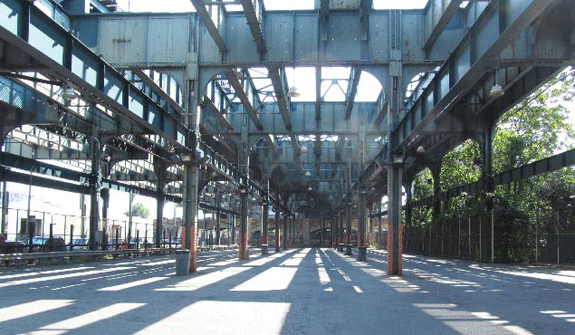
Pratt Center
Pratt Center's Joan Byron Gives Testimony on East New York Rezoning Proposal

Testimony of Joan Byron, Director of Policy
Draft Scope of Work for an Environmental Impact Statement
East New York Rezoning Proposal
March 5, 2015
I speak on behalf of my organization, the Pratt Center for Community Development, in support of the testimony already given by Cypress Hills Local Development Corporation, and members of the Coalition for Community Advancement: Progress for Cypress Hills and East New York.
We are concerned that the study methodology will understate the risk that industrial businesses will be displaced, and that the well-paying jobs of the workers now employed will be lost.
We are especially concerned that the Department of City Planning (DCP) is proposing to replace significant areas of now industrially-zoned land with MX, which it states will promote a mix of industrial, commercial, and residential uses.
The actual experience with MX zones mapped throughout the city demonstrates that MX has failed to promote a real mix of uses or to preserve land for manufacturing. The opposite has been true.
We have examined MX zones mapped throughout the city. Without exception, these rezonings have resulted in a loss of industrial land. The speed and extent of loss varies, both with the strength of local markets and with the economic cycle, but it occurs across all neighborhoods.
In the 14 MX districts mapped in NYC, a total 41% of industrial space, which represents over 4.2 million square feet, was lost by 2014. Residential lot square footage, including mixed residential and commercial land use, increased by 71%.
The simple reason is that both retail and residential uses generate much higher returns on land.
- Any change to MX will result in manufacturing displacement due to the ability to attract users bringing in a higher rent;
- MX will also encourage real estate speculation and open the opportunity to convert the land to residential uses, especially near transit nodes like Broadway Junction
- There are a significant number of manufacturing and industrial users along Atlantic and Liberty Ave that would be threatened and displaced under the proposed zoning changes including long time businesses such as Mrs. Maxwell’s Bakery (est. 1928) and National Metal Enclosures (est. 1940). These are businesses that have survived the contraction of the sector and are strongly competitive because they produce products for which there is a strong local market in NYC. The biggest threat to their continuing survival and growth is the lack of stable and affordable space.
- Encouraging residential development in close proximity to industrial areas may present conflicts between businesses and neighbors as industrial users require truck transport and access, on street parking, and early / late operating hours. Community conflict could potentially lead to erosion of the industrial business zone in the future.
We are also concerned that the City has expressed its intent to rezone industrial land in other neighborhoods for mixed or residential use. This will mean that businesses displaced from East New York will be unable to find land in other neighborhoods to which they can afford to relocate. Consequently, the cumulative impact on the entire manufacturing sector and its workers will be even greater than the sum of impacts suggested by individual rezonings. We call upon DCP to examine the cumulative impact of all rezoning of industrial land that it contemplates under the housing plan.
Loss of living wage jobs and their replacement by poorly paid, often part time retail and service work will mean that industrial workers now earning a living wage, who can now afford to provide their families with decent housing in East New York will be forced to compete with their neighbors for housing affordable for the few units of very low and extremely low-income housing that this plan will create.